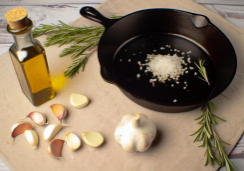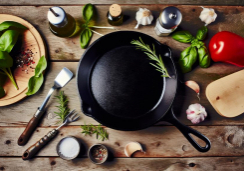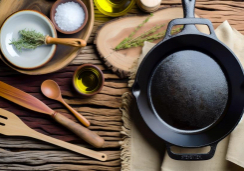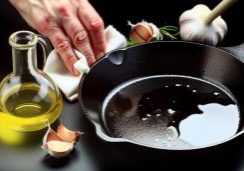Why Season Your Cast Iron Skillet? Step-by-Step Guide
A stitch in time saves nine, and when it comes to cast iron skillets, seasoning is that crucial stitch. You've likely heard that a well-seasoned skillet not only enhances your cooking but also stands the test of time, yet you might be wondering what the fuss is all about.
Seasoning your skillet isn't just a one-off task; it's an ongoing process that builds character and flavor into every meal you cook. In this guide, you'll learn the simple yet essential steps to properly season your cast iron skillet, ensuring it remains a treasured kitchen staple for years to come.
So, grab your skillet, and let's get started—but remember, the true secret to a perfectly seasoned pan lies in the details that follow.
The Importance of Seasoning
Understanding the importance of seasoning your cast iron skillet is key, as it not only prevents rust and unwanted sticking but also enhances your cooking experience with each use. Seasoning forms a protective layer on your beloved cast iron cookware, ensuring that each meal you whip up isn't marred by the frustration of food clinging stubbornly to the cooking surface.
Imagine a warrior arming themselves before battle; that's what you're doing when you season your skillet. You're creating a barrier armed against the natural enemies of cast iron: moisture and wear. A layer of oil baked onto the skillet through a process called polymerization transforms into a protective coating. This blackened shield not only wards off rust but also develops nonstick properties that chefs dream of.
The more you cook with fats and oils, the stronger this armor becomes. Your skillet evolves with every use, becoming more adept at handling whatever culinary challenge you throw at it. Even acidic foods, which can typically be problematic for cast iron, become fair game on a well-seasoned surface.
Cleaning Your Skillet Properly
To maintain your skillet's hard-earned seasoning, it's crucial to clean it correctly, avoiding soaps or harsh chemicals that can strip away the nonstick surface you've built up. After each use of your cast iron pan, let it cool down a bit before you tackle the cleaning.
A stiff brush and hot water are your best friends here. They'll help you scrub off any stuck-on bits without damaging the seasoning process you've worked so hard on.
If you encounter stubborn food residue, a sprinkle of kosher salt can be your ally. This gritty companion works wonders for dislodging tough spots. After you've scoured the pan, rinse it thoroughly to ensure the pan is clean. Remember to avoid using too much water, as cast iron is prone to rust when left wet.
Once you've rinsed your skillet, place it back on the stove over low heat to dry completely. This step is vital to prevent rust and to prepare the pan for a light re-seasoning. You'll want to carefully remove all moisture before adding a thin layer of oil, maintaining that slick, nonstick patina.
This simple but effective routine will keep your cast iron skillet in prime condition, ready for your next culinary adventure.
Applying the Seasoning Oil
Having cleaned and dried your cast iron skillet, it's time to apply a protective layer of seasoning oil to enhance its nonstick surface and durability. To season a cast iron, start by selecting a neutral oil — grapeseed, canola, or even flaxseed oil works wonders. Pour a teaspoon of oil into the pan and use a paper towel to spread it around, ensuring a thin layer coats every inch, including the handle, sides, and bottom.
As you oil the pan, make sure to rub it in well; the goal is to leave a sheen without any excess. A common error is using too much oil, which leads to a sticky residue after heating. To avoid this, take another clean towel and gently buff off any surplus, leaving just enough to glisten.
Now, place your pan upside down in a preheated 450°F oven. This position prevents oil from pooling. Bake for 30 minutes to let the oil polymerize, forming a solid, protective layer. After heating, let it cool in the oven.
You'll want to repeat this process three to four times, building up a robust seasoning. With each application, the pan's resilience and nonstick qualities will improve, rewarding you with a superior cooking surface for years to come.
Baking the Skillet for Durability
By baking your cast iron skillet with a thin layer of oil, you're essentially armoring it against the perils of rust and food sticking, ensuring its longevity and ease of use. When you season a cast-iron pan, you're not just coating it; you're transforming it.
The heat from the oven polymerizes the oil, bonding it to the surface of the cast-iron skillet to create a hard, blackened layer. This is the secret to that coveted, non-stick patina that makes a well-seasoned cast-iron skillet a culinary treasure.
The process of baking the skillet for durability is as much science as it's art. You're aiming for an oil with a high smoke point to withstand the oven's heat without burning. As you layer and bake, the skillet's resilience increases. The initial good layer of seasoning you build up is crucial.
It not only enhances the pan's durability but also makes it more water-resistant, preventing rust and ensuring that each meal you cook is better than the last.
Is There a Difference Between Seasoning a Cast Iron Skillet and Perfect Cast Iron Skillet Seasoning?
Seasoning a cast iron skillet is crucial for its maintenance and longevity. Following a stepbystep cast iron seasoning process ensures that the skillet develops a non-stick surface and prevents rusting. Perfect cast iron skillet seasoning involves applying oil, baking, and cooling the skillet for a flawless finish.
Maintaining Your Seasoned Skillet
After baking your cast iron skillet to create a durable, non-stick surface, you'll need to keep up with maintenance to preserve its top-notch condition. Regularly cleaning your pan after each use ensures that foods from sticking become a rare sight. Remember to dry it thoroughly; moisture is the enemy of cast iron and carbon steel alike.
Now, let's talk about the best oil for the job. You'll want to lightly coat your skillet, turning the skillet upside down to make sure no excess pools at the bottom. This process, called polymerization, is what gives your pan that coveted non-stick patina. Place the oiled skillet in a preheated 450°F oven for 30 minutes. This step helps solidify the season your cast-iron needs, creating a barrier against rust and corrosion.
Make it a habit to reach for your seasoned skillet every time you cook. The more you use it, especially for fat-heavy dishes, the better the seasoning becomes. Think of it as a relationship with your new pan: the more care and quality time you invest, the more fruitful it becomes.
Lastly, re-season your skillet one to two times a year. After you've done the heavy-duty cleaning or when you notice dull spots, give it some love with a fresh coat of cooking oil and heat. Store it in a dry place, and you're all set for a lifetime of superb sizzling and searing.
Conclusion
Now you've got the know-how to keep that cast iron skillet in tip-top shape.
Remember, it's all about that protective seasoning—your barrier against rust and stickiness.
Clean it gently, oil it up, and bake that skillet to harden the magic layer.
Keep cooking, and that patina will just get better, making your skillet a trusty, nonstick companion in the kitchen.
Treat it right, and it'll reward you with a lifetime of delicious meals.
Happy cooking!










